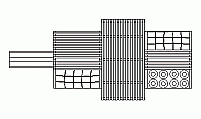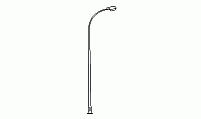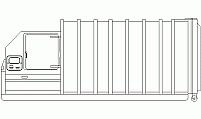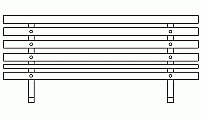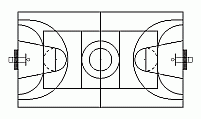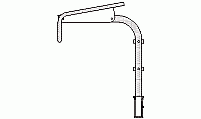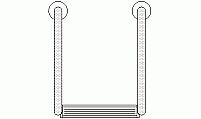CAD Blocks categories
 3D models
3D models home furniture
home furniture sanitary ware - bathrooms
sanitary ware - bathrooms professional equipment
professional equipment doors and windows
doors and windows people and animals
people and animals plants and trees
plants and trees vehicles - transports
vehicles - transports architectural details
architectural details mechanical - electrical
mechanical - electrical urban planning - civil works
urban planning - civil works safety health construction
safety health construction accessible design
accessible design drawing sheet
drawing sheet signals
signals construction machinery
construction machinery accessories and objects
accessories and objects maps and street maps
maps and street maps
Side Pedestrian Traffic Light CAD Block with Complete Specifications

size: 5 kb
category: street furniture
related categories:
description: This CAD block showcases a side-mounted pedestrian traffic light with housing, visor, and control systems designed for urban crosswalks.
file extension: .dwg CAD - AutoCAD software
Detailed Dimensions, Materials, and Safety Guidelines for Pedestrian Traffic Lights
Features of the Side Pedestrian Traffic Light
The side pedestrian traffic light is a critical urban infrastructure element designed to ensure pedestrian safety at crossings. These traffic lights are mounted on poles near crosswalks and typically feature illuminated symbols such as a "walking person" to indicate safe crossing and a "upraised hand" to signal when crossing is prohibited. Modern designs incorporate LED technology, which enhances visibility, reduces energy consumption, and extends the lifespan of the signals. The structure includes a durable housing, a visor to reduce glare, and internal control circuitry for efficient operation.
These traffic lights are designed to withstand harsh outdoor conditions, with housing made from weather-resistant materials such as polycarbonate or aluminum. Their compact and sleek design ensures minimal obstruction to pedestrian pathways while providing clear visibility from various angles. The use of universal symbols ensures accessibility and comprehension across different cultures and languages. This design complies with international standards, ensuring functionality and reliability in urban environments, and is suitable for integration with broader traffic management systems.
Common Dimensions and Specifications
The dimensions of side pedestrian traffic lights are standardized to ensure visibility and compliance with local regulations. In the United States, the Institute of Transportation Engineers (ITE) specifies common sizes such as 12 inches by 12 inches (305 mm x 305 mm) for individual signal faces and 16 inches by 18 inches (406 mm x 457 mm) for dual configurations. The mounting height typically ranges from 7 feet (2.1 meters) to 10 feet (3 meters), ensuring signals are easily visible without obstructing pedestrian movement.
Visors are often included in the design to minimize glare, and the signal heads are angled for optimal visibility. LED modules are designed with pixel configurations that offer clear and bright indications, even under direct sunlight. The control systems are housed within compact enclosures that are weatherproof and vandal-resistant. These dimensions and design features ensure that the signals meet the needs of various urban settings while maintaining universal accessibility and safety compliance.
Materials and Composition
Side pedestrian traffic lights are constructed using materials that ensure durability and weather resistance. The housing is commonly made from polycarbonate or aluminum, both of which offer high resistance to corrosion and impact. The lenses are crafted from UV-resistant polycarbonate, which prevents discoloration and maintains clarity over time. LED modules are used for their long lifespan, energy efficiency, and excellent visibility under various lighting conditions. These components are enclosed in weatherproof housings to protect against rain, dust, and extreme temperatures.
Internal wiring and control circuitry are designed to withstand temperature fluctuations and moisture, ensuring reliable operation in diverse climates. Stainless steel fasteners are used to secure components, providing added strength and resistance to rust. Additionally, visors or hoods are incorporated to reduce glare and enhance signal visibility during daytime hours. This careful selection of materials ensures that the traffic lights perform reliably in demanding urban environments, meeting the safety and durability standards required for public infrastructure.
Safety Standards and Regulations
Side pedestrian traffic lights are governed by stringent safety standards to ensure they provide reliable guidance to pedestrians. In the United States, the Manual on Uniform Traffic Control Devices (MUTCD) outlines detailed requirements for the design, installation, and operation of pedestrian signals. Similarly, international standards, such as those from the International Electrotechnical Commission (IEC) and the European Committee for Standardization (CEN), offer guidance on safety and performance. These standards ensure that signals are visible, reliable, and provide adequate crossing time for pedestrians, including those with disabilities.
Regular maintenance and inspections are mandated to address potential malfunctions or damages promptly. This includes cleaning lenses, checking LED functionality, and ensuring the structural integrity of the mounting poles. Compliance with these regulations minimizes the risk of accidents and enhances pedestrian safety at crossings. Additionally, some modern systems integrate with smart traffic management systems, offering adaptive signal timing and real-time monitoring to further improve safety and efficiency.
Frequently Asked Questions
- What symbols are used in side pedestrian traffic lights?
- Standard symbols include a "walking person" to indicate it is safe to cross and an "upraised hand" to signal pedestrians to wait. These universally recognized icons provide clear guidance and help ensure safety at crosswalks.
- Why are LEDs used in modern pedestrian traffic lights?
- LEDs are preferred for their energy efficiency, long lifespan, and superior visibility. They consume significantly less energy compared to incandescent bulbs and provide brighter, clearer indications, even in adverse weather conditions.
- What are the typical dimensions of pedestrian traffic lights?
- Common dimensions for pedestrian traffic lights include 12 inches by 12 inches (305 mm x 305 mm) for individual signal heads and 16 inches by 18 inches (406 mm x 457 mm) for dual configurations. These dimensions ensure clear visibility and compliance with safety standards.
- How are pedestrian signals synchronized with vehicular traffic lights?
- Pedestrian signals are integrated into traffic signal systems, aligning pedestrian crossing phases with vehicular stop phases. This synchronization reduces conflicts between pedestrians and vehicles, enhancing safety and traffic flow.
- What maintenance is required for pedestrian traffic lights?
- Regular maintenance involves cleaning lenses, inspecting LED modules for functionality, checking structural integrity, and ensuring that control systems are operational. Timely maintenance prevents signal failures and enhances pedestrian safety.











